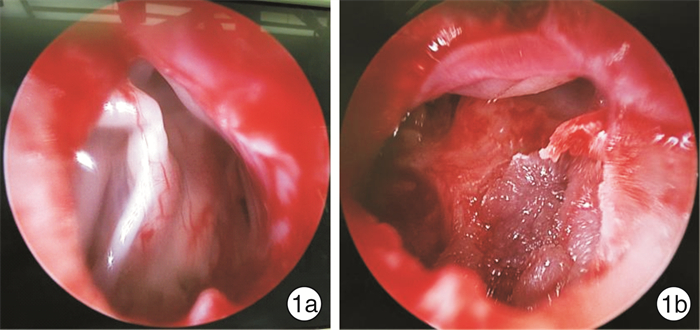Surgical methods of cerebrospinal fluid otorhinorrhea due to inner ear malformation in children
-
摘要: 目的 探讨经乳突入路与经耳道耳内镜入路两种手术方式在儿童内耳畸形相关脑脊液耳漏治疗中的应用。方法 回顾性分析2015年7月—2021年1月北京儿童医院耳鼻咽喉头颈外科手术确诊的内耳畸形相关脑脊液耳漏患儿,记录一般临床资料、手术方式、术后并发症、复发及随访情况。结果 共30例患儿经手术确诊为内耳畸形相关脑脊液耳漏。50.0%有耳鼻漏史,53.3%首次发病即确诊。单侧畸形22例,均因脑脊液耳漏继发感染症状首诊;9.1%因脑膜炎后耳聋植入耳蜗。双侧畸形8例,87.5%因双侧听力障碍首诊且行耳蜗植入手术;脑脊液耳漏96.7%为单侧,其发生与耳蜗植入侧别及时间无关。经乳突入路14例,多涉及耳蜗植入及其他相关手术;经耳道耳内镜入路16例。经乳突组年龄小于经耳内镜组,无复发及并发症。经耳内镜组2例复发,2例出现暂时性面瘫,1例出现迷路及颅内积气。除1例失访外,其余患儿随访1.2~6.7年,无肺炎、脑膜炎及脑脊液耳鼻漏复发,继续随访。结论 单侧内耳畸形导致脑脊液耳漏多因脑膜炎或肺炎就诊,双侧多因听力障碍需耳蜗植入干预。经乳突与经耳内镜脑脊液耳漏修补术手术效果相当,前者适用于需乳突探查、耳蜗植入或合并其他手术者;后者适用于漏口局限于鼓室、耳道直径够宽的患儿。Abstract: Objective To discuss the application of two surgical methods, trans-mastoid approach and trans-canal endoscopic approach, in the treatment of CerebroSpinal Fluid(CSF) otorhinorrhea due to inner ear malformation(IEM) in children.Methods Children with CSF otorhinorrhea due to IEM, from July 2015 to Jan 2021, in ENT department, Beijing Children's Hospital were retrospectively analyzed, and the clinical data, surgical methods, complications, recurrence and follow-up were recorded.Results 30 children with CSF otorhinorrhea due to IEM were included. Half of them had a history of otorhinorrhea, and 53.3% of them were diagnosed as cerebrospinal fluid(CSF) otorrhea at the first onset Unilateral and bilateral IEM were 22 cases and 8 cases respectively. All unilateral IEM children had secondary infections such as meningitis or/and pneumonia, and 9.1% had cochlear implantation(CI) due to deafness after meningitis. 87.5% bilateral IEM children had CI due to profound/severe hearing loss. 96.7% CSF otorhinorrhea were unilateral, there was no relationship between CSF otorhinorrhea and the malformation side or the time of CI surgery. Trans-mastoid approach was used in 14 cases, usually involving CI or other operations; and endoscopic approach in 16 cases. The age of trans-mastoid group was younger than that of endoscopic group. No recurrence and complications occured in the trans-mastoid group. In the endoscopic group, 2 cases recurred; 3 cases had complications(2 with temporary facial paralysis and 1 with labyrinth and intracranial pneumatosis). Except one case lost, the others were followed up for 1.2-6.7 years, and no recurrence of pneumonia, meningitis and CSF otorhinorrhea happened.Conclusion Unilateral IEM usually leads to meningitis or/and pneumonia, and bilateral IEM requires CI. Both trans-mastoid and trans-canal endoscopic approach were effective for CSF otorrhea repair. Trans-mastoid approach is suitable for those who need mastoid exploration, CI or combined with other operations. Trans-canal endoscopic approach was choosed when fistula was confined to the tympanum and ear canal diameter was wide enough.
-

-
[1] 中华医学会神经外科学分会. 脑脊液漏规范化管理中国专家共识[J]. 中华医学杂志, 2022, 102(15): 1057-1067. doi: 10.3760/cma.j.cn112137-20220128-00207
[2] Ng MMY, D'Arco F, Chorbachi R, et al. Oval window perilymph fistula in child with recurrent meningitis and unilateral hearing loss[J]. BMJ Case Rep, 2020, 13(7): e234744. doi: 10.1136/bcr-2020-234744
[3] Sennaroglu L, Bajin MD. Management of stapes footplate fistula in inner ear malformations[J]. Int J Pediatr Otorhinolaryngol, 2021, 140: 110525. doi: 10.1016/j.ijporl.2020.110525
[4] Kou YF, Zhu VF, Kutz JW Jr, et al. Transcanal Endoscopic Management of Cerebrospinal Fluid Otorrhea Secondary to Congenital Inner Ear Malformations[J]. Otol Neurotol, 2016, 37(1): 62-65. doi: 10.1097/MAO.0000000000000898
[5] Deng W, Liu J, Pang F, et al. Diagnosis and management of pediatric cerebrospinal fluid leakage secondary to inner ear malformations: A report of 13 cases[J]. Int J Pediatr Otorhinolaryngol, 2020, 135: 110049. doi: 10.1016/j.ijporl.2020.110049
[6] Sennaroǧlu L, Bajin MD. Classification and Current Management of Inner Ear Malformations[J]. Balkan Med J, 2017, 34(5): 397-411. doi: 10.4274/balkanmedj.2017.0367
[7] 陈敏, 郑军, 刘薇, 等. 儿童脑脊液耳漏修补与人工耳蜗植入同期手术的探讨[J]. 中华耳科学杂志, 2020, 18(4): 802-806. doi: 10.3969/j.issn.1672-2922.2020.04.036
[8] Muzzi E, Battelino S, Gregori M, et al. Life-threatening unilateral hearing impairments. Review of the literature on the association between inner ear malformations and meningitis[J]. Int J Pediatr Otorhinolaryngol, 2015, 79(12): 1969-1974. doi: 10.1016/j.ijporl.2015.09.028
[9] 王玥, 刘芊, 王海波. 自发性脑脊液耳漏的研究进展[J]. 山东大学耳鼻喉眼学报, 2019, 33(2): 130-135, 142. https://www.cnki.com.cn/Article/CJFDTOTAL-SDYU201902028.htm
[10] Wang B, Dai WJ, Cheng XT, et al. Cerebrospinal fluid otorrhea secondary to congenital inner ear dysplasia: diagnosis and management of 18 cases[J]. J Zhejiang Univ Sci B, 2019, 20(2): 156-163. doi: 10.1631/jzus.B1800224
[11] 雷雳, 李永新, 赵守琴, 等. 儿童先天性内耳畸形伴再发性脑膜炎26例临床分析[J]. 中华耳科学杂志, 2020, 18(2): 325-328. doi: 10.3969/j.issn.1672-2922.2020.02.020
[12] 龙丹, 张春林. 内耳不完全分隔Ⅲ型畸形致复发性脑膜炎1例[J]. 听力学及言语疾病杂志, 2022, 30(5): 563-565. https://www.cnki.com.cn/Article/CJFDTOTAL-TLXJ202205026.htm
-





 下载:
下载:


